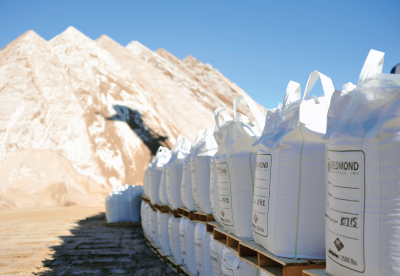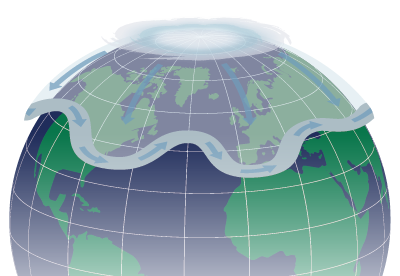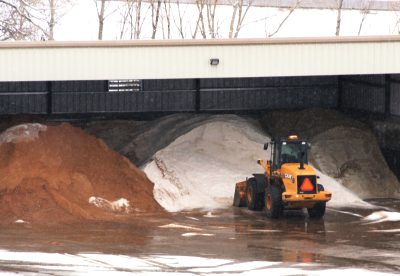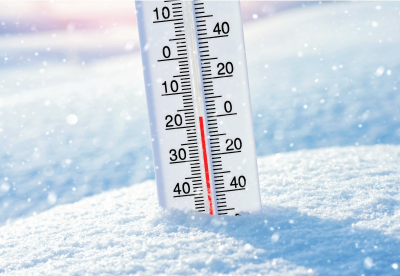Date December 8, 2021 | Brooke Loeffler
What is the difference between anti-icers and deicers?
Winter road treatments ultimately have one goal in common: to make roads safer during the winter. Each category: liquid anti-icers, solid deicers, and aggregates, try to accomplish this in different ways and with varied effectiveness.
What are Liquid Anti-icers?
Liquid anti-icers are solutions that can be used to pre-treat surfaces to prevent ice from forming and bonding to the pavement. They are typically sprayed over walkways and roads before snowfall occurs. Each batch must be mixed to proper concentrations depending upon the temperatures of both the air and pavement.

Liquid Pros
- Liquid anti-icers do not bounce and scatter when applied to the road surface, so they can usually be applied with precision.
- They also embed well in the nooks and crannies of the surface and provide good coverage.
- Liquids begin working immediately, as there is no wait time for it to turn into brine.
Liquid Cons
- Part of the downside to liquid anti-icers lies in the name itself...anti-icer, not deicer. These products are intended to be used as a preventative measure, but are not effective when applied to roads where ice and snow have already accumulated. When you attempt to use liquid anti-icers on pre-existing ice, conditions can become even more slick and dangerous.
- In general, liquids are more difficult to store and transport than solids and require specialized tanks.
- They also require additional personnel training with freeze point curve tables to make sure they are mixed in the correct concentrations for certain temperature ranges. During very cold temperatures, if the ratios are not right, they can actually create ice instead of preventing it.
- Liquids run off of sloped surfaces, making it difficult to ensure even coverage on grades or banking roads.
- Liquid anti-icers can also be washed away by rainfall. Winter weather can be unpredictable and fluctuate above and below 32° F. When you receive a sleety mix of rain and snow, all of your efforts can be washed down the storm drain before they even have a chance to work.
- When working with liquid anti-icers you have a much more narrow window of use between: timing, weather conditions, and differences between air and pavement temperatures.
- It can be difficult to tell which roads have already been treated.
- Liquids anti-icers do not provide additional traction. Sometimes, road crews feel the need to apply additional aggregates to improve pavement friction.
What are Aggregates?
Aggregates are a broad family of coarse grain solids that stay solid and do not melt into liquids. They are sometimes applied to increase traction and improve pavement friction on weather affected roads and paths. The most common aggregates are sand, gravel, and a variety of geo-synthetics.

Aggregate Cons
- Aggregates are not freeze point depressants and do not lower the freezing temperature of ice and snow (they are not anti-icers or deicers).
- Because they are not water soluble and do not melt, they require expensive and time-consuming clean up.
- Aggregates clog roadside drainage and artificially shallow waterways.
- They increase air particulate pollution during transport, application, and as vehicles continue to driver over them.
- Aggregates cause a lot of damage to windshields, and other property.
Watch our fun experiment where we put Ice Slicer and gravel head to head to see which is safer for your windshield!
What are Solid Deicers?
Solid deicers are granules that vary in size, shape, coarseness, and chemical or mineral composition. They contain freeze point depressants that lower the freezing point of water. Deicers are applied to walkways and roads to penetrate ice and snow, form brine, and melt ice that has already bonded with the pavement. They can also prevent ice from continuing to accumulate, depending upon the performance of the product. Coarse, granular deicers are also used to provide extra traction and improve pavement friction.

Pre-wet Solids
Some solid deicers can be pre-treated with a liquid solution. Pre-wetting can help prevent product from bouncing and scattering off the roadway, kickstart the brining reaction, reduce how much product is needed, and boost its performance.
• Learn more about pre-wetting deicers.
Solid Deicer Pros
- Granules work effectively both on bare pavement or where ice and snow has already accumulated. Their mass allows them to vertically penetrate ice and snow in order to reach the pavement surface.
- Solids are easier to store and transport than liquids and don’t require specialized tanks. Because of this, granular deicers can be distributed in a much wider variety of vehicles. This is extremely helpful for operations using a fleet of vehicles or municipalities that use subcontractors for deicer application.
- Granular deicers provide skid resistance without needing additional aggregates. The best deicers have a range of granule sizes so the smaller granules melt quickly into brine and the larger granules melt slower and provide needed traction.
- With granules, it is much easier to see which roads have already been treated. This reduces the likelihood of wastefully double applying deicer.
- Granular deicers can be applied much more quickly than liquids.
- When using granular deicers, there is much less room for user error. Because there are no concentrations to mix, dilutions to calculate, and sprayers to operate, it is easier and more efficient to use granules.
- Granular deicers do not dilute as quickly and can continue working to prevent re-freezing cycles.
Solid Deicer Cons
- Lighter granules can bounce and scatter. Choose a coarse grained deicer with a mixture of large and small granules to help keep your product where you need it.
- After periods of storage, granular deicers can clump together. Before applying to the road surface, make sure clumps are broken up for more even distribution.
- For some, it is easy to get carried away and use too much. Overuse of deicers can increase costs, corrosion, and environmental impact. Be sure to use a high performing deicer that will give you more with less.
The Power of Ice Slicer®
With the exception of certain very high-performance liquid deicers, granular deicers are more effective in colder temperatures and in high precipitation conditions. Ice Slicer® is proud to offer all of the benefits of granular deicers, without the drawbacks.

Our special mixture of coarse granule sizes reduces bounce and scatter, making it easier to keep your deicer where it is needed most. With a homogeneous blend of over 60 naturally occurring minerals, our grains are high performing, less corrosive, and safer for the environment than traditional white salt. More powerful performance means you can save money by getting greater deicing benefits with a smaller amount of product.
© 2024 Redmond Minerals Inc.






